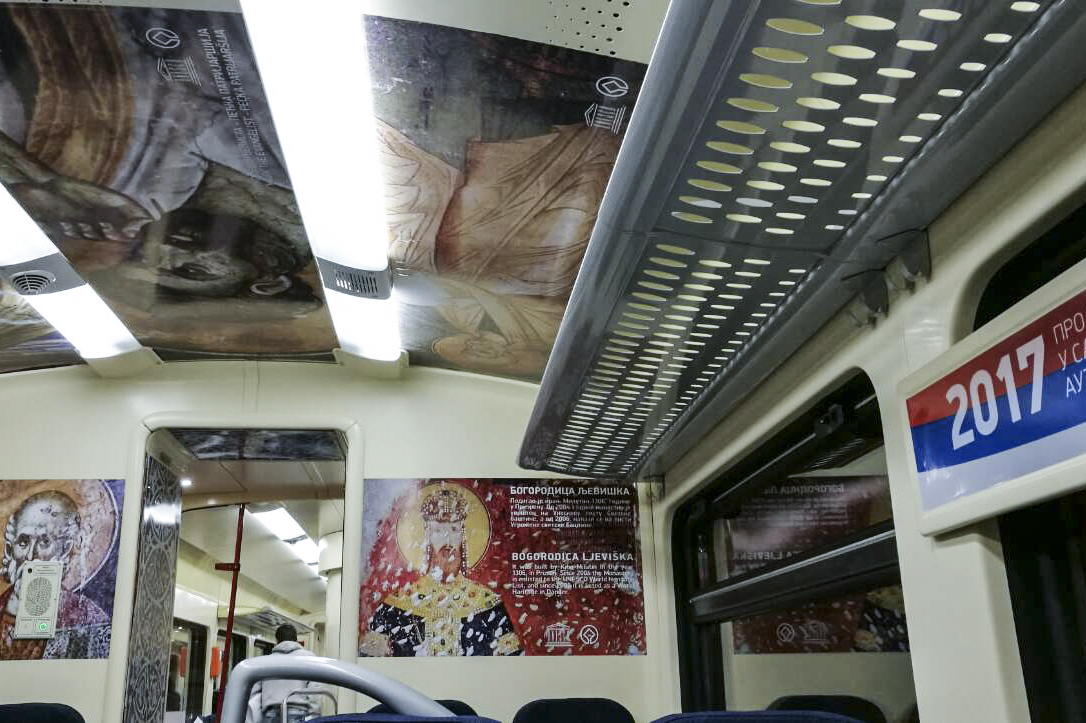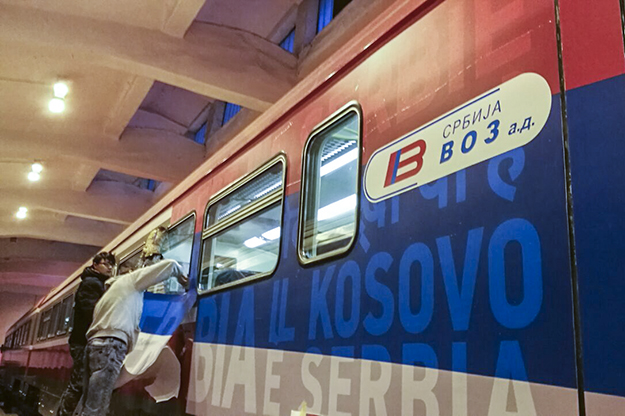A train marked with ‘Kosovo is Serbia’ signs in more than 20 languages and painted internally with frescos, began its journey from Belgrade to North Mitrovica on Saturday (January 14) with no prior announcement or agreement with Pristina. In the evening of the same day, the train stopped in Raska, Serbia, and returned to Belgrade.
In Serbia, the story is that the train returned based on the call of the prime minister, Aleksandar Vucic, and his statement that it was made for the safety of the passengers. According to Serbian officials, the train did not represent any provocation. Initial Serbian media reports held that mines had been laid on the tracks, something that has been categorically denied by Prishtina. In Kosovo, the story is that the train returned as the authorities called to prevent it from entering.
Almost one week later, the Serbian public is still not fully aware of what actually happened on that day. Neither has the issue of who commissioned the train’s interior, which across social media has come to be known as the “moving church,” been resolved; not even Serbia’s prime minister, at least based on what he has declared, knows the answer: “I did not participate in that, I didn’t even know how the train looked. I saw it on TV Pink when Marko Djuric [director of the government Office for Kosovo] exhibited it,” Aleksandar Vucic said on Sunday.

However, what many across the non-governmental sector in Serbia agree upon is that the main purpose of the train was to kick off an election campaign. With regular presidential elections set for spring, and the general belief that current president Tomislav Nikolic’s chances of securing another term are slim, many, including prime minister Vucic himself, have been hinting at the prospect of extraordinary parliamentary elections.
Along these lines, sociologist and political analyst Jovo Bakic told K2.0 that the train was not a smart move from the perspective of the interests of Serbia and Serbs, but rather for the purposes of an election campaign. According to him, the move was irresponsible, “because everybody was playing with fire irresponsibly.”
“The cost of this playing around is, above all, in raising interethnic tensions and less so when it comes to joining the EU, since the latter is far-fetched anyway,” Bakic said. “It is most certainly a well-thought out provocation, demonstrated by the iconography of the train, and especially the presence of Misa Vacic, famous right-wing extremist and a very close collaborator of Aleksandar Vucic, in the train.”
The Belgrade Center for Security Policy researcher Maja Bjelos told K2.0 that since 2012 the government has been known to cause scandals and to fabricate. For her, the case of the train is yet another entry on a long list of affairs from Serbia’s current leaders as well as an inappropriate and short-sighted move with the aim of gaining political points and raising their own ratings at the expense of ordinary citizens.
“Unfortunately, this move was well thought out, carried out by a plan in a given time frame,” Bjelos said. “In the context of Serbian politics, this affair is interpreted as ‘timed’ as part of the presidential election campaign and is seen as an attempt to flood the media and social networks with information in order to direct the attention from the presidential candidacy of Vuk Jeremic, as well as writing about Sasa Jankovic [the ombudsperson, who has declared his candidacy for the presidential elections].”
According to Bjelos, with the existing leaders in Serbia and Kosovo and their politics, it is impossible to establish normal relations between the two countries, since the issues that are seemingly of importance to the normal everyday lives of citizens — such as opening train routes — are politicized and securitized for political gain. She adds that citizens from both communities are the biggest losers in this situation, especially if they support authoritarian regimes that create tensions, produce fear and control the population by doing so.
“I believe that there is a critical mass of citizens in Serbia, as well as representatives of civil society, who do not approve of the current politics, and are critically examining the current move of the government, but also similar moves, and are objectively analysing the situation and the consequences,” Bjelos said. “Citizens even try to incorporate a bit of raciness and humor into the senselessness. For example, suggesting what would be written on a train from Vojvodina or how a train travelling to Zagreb would look.”
Bjelos adds that she believes more needs to be done to challenge the approach to date from politicians in Belgrade and Prishtina, including more civil society organizations and citizens in Kosovo challenging the politics of the Prishtina government towards Serbia and the integration of Kosovar Serbs.
The director of the Center for Euro-Atlantic Studies Jelena Milic told K2.0 that she is not certain whether the issue of the train is even a matter solely for the Serbian government, bearing in mind that Russian media Sputnik followed the events on that day on their website and social networks, and communicated that it was “a Russian train with Serbian icons that is travelling to Kosovska Mitrovica.”
“The question is, who did the director of the government’s Office for Kosovo and Metohija, Marko Djuric, do this in coordination with, since the prime minister declared that he didn’t know of the train. Or the prime minister is not speaking the truth, which wouldn’t be his first time,” Milic said. “It is an interesting and cynical use, or misuse of the notion of ‘freedom of movement’ used by the Serbian authorities, since freedom of movement doesn’t also mean anarchy.” An example of the former is that a train has been travelling for years from Kraljevo to North Mitrovica; the difference between this train and the one that started off from Belgrade on Saturday is that everybody knew about the one from Kraljevo.

Milic puts the entire story into the wider context of the series of “dangerous incidents and statements in the region,” which have occurred almost simultaneously, including the arrest of former prime minister of Kosovo, Ramush Haradinaj, in France on an Interpol warrant issued by Serbia.
“Haradinaj’s arrest, no matter how controversial considering that he travels a lot internationally, has also been … used,” Milic said. “It’s obvious that Serbia, which hasn’t had a prosecutor for war crimes for a year and a half, still isn’t working on the cases of those suspected of war crimes in Serbia and top government officials, but on this case. There have already been indications that Serbia is distancing itself from the Brussels Agreement and the essential Europeanization. Now, a step further is being made — into active destabilization.”
Following the situation with the train, things in Serbia are still not calming down. Much of the public’s attention has been attracted by the statements of President Tomislav Nikolic. His assertion that, out of necessity for the safety of Serbs he would send the army to Kosovo, has been evaluated by many Serbs as warmongering rhetoric.
Is it worth lowering the reputation of Serbia and raising tensions for the purposes of an election campaign? From the perspective of many citizens it is certainly not. It remains to be seen in spring’s elections whether somebody will benefit from all of this.K

